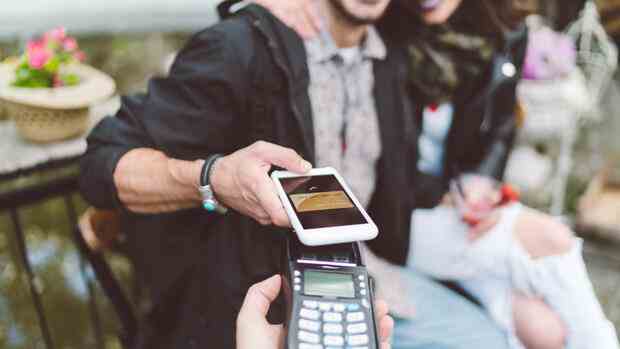Most consumers in Germany still prefer cash payments.
(Photo: E+/Getty Images)
Frankfurt Even four years after the launch of Apple Pay in Germany, only a fraction of consumers use their smartphones to pay at the checkout. Only eight percent of Germans pay for purchases via smartphone, for example via the payment services from Apple and Google, Apple Pay and Google Pay. This was the result of a survey commissioned by the auditing and consulting firm PwC.
This is even a small decrease compared to 2020, when nine percent of those surveyed said they paid by smartphone. In 2018 it was five percent.
The use of mobile phone payments is surprisingly slow in Germany and is well below the average – 15 percent – in Western Europe. In the Netherlands, 22 percent of consumers said they paid by smartphone, and 29 percent in Switzerland. In France, on the other hand, it was only six percent. PwC surveyed nearly 5,800 people in 15 countries online.
The PwC experts attribute the small proportion of German consumers who pay with smartphones to three main factors:
Top jobs of the day
Find the best jobs now and
be notified by email.
- Firstly, the preference for cash in this country is comparatively high.
More than half of those surveyed prefer to pay with bills and coins. The average across the 15 countries is 37 percent.
- Secondly, PwC points out that the popular Girocard (formerly “EC card”) only works to a limited extent with Apple Pay or Google Pay.
Since the summer of 2020, the savings banks have been offering customers the option of depositing their Girocard with Apple Pay. The private National Bank is planning this step.
New Girocards are easier to use with Apple Pay
Mastercard and Visa debit and credit cards mostly work with Apple Pay and Google Pay, and in some countries banks primarily issue these card types. But in Germany, the Girocard, of which 100 million are in circulation, is used much more. Many people only have one Girocard. Recently, contactless payment by Girocard had increased. You have to hold the card close to the card reader at the cash register, but don’t insert it anymore.
- And thirdly, there is no established payment solution for mobile phones in Germany, as is the case in Sweden with “Swish” and in Switzerland with “Twint”, according to PwC.
The majority of German financial institutions have agreed on an app for cellphone-to-cellphone payments, “Kwitt”, but not for paying at the checkout. Such an app could be based on QR codes so that it can be used on all maps and mobile phone types like the counterparts in Sweden and Switzerland.
Apple Pay and Google Pay work via NFC technology, short for Near Field Communication. To pay, the user holds their smartphone close to the checkout terminal, like making contactless payments with the Girocard or other bank cards.
Nevertheless, PwC assumes that mobile phone payments will also increase in Germany:
“In the end, of course, it is up to the individual banks to decide whether they want to activate the functions for mobile payment methods and make them available to their customers,” says Johannes Gärtner, Director at Strategy& at PwC. However, with the replacement of the Maestro Girocards by Debit Mastercard and Visa Debit Girocards, a significant expansion of the user base in Germany is to be expected.
Elsewhere, there is greater skepticism about tech companies. Around three quarters of those surveyed in Germany cannot imagine opening an account with a tech company. For Apple, the value is only two percent, Google comes to six percent. An account with the US online payment service PayPal would be conceivable for 17 percent. In most other countries, the reluctance is somewhat lower, especially with regard to Apple and Google.
More: German banks are more profitable than they have been in ten years
